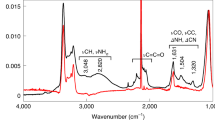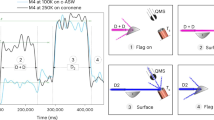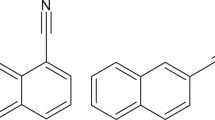Abstract
CONSIDERING the properties of galactic dust clouds in the wavelength region 8–12 µm Wickramasinghe1 concluded that formaldehyde undergoes polymerisation in interstellar space to polyformaldehyde. Applying more stringent constraints for matching infrared spectra of galactic sources over the waveband 2.5–30 µm Hoyle and Wickramasinghe2,3 recently argued for the identification of interstellar polysaccharides—which could be regarded as a further chemical evolution of formaldehyde polymers. A considerable fraction of all interstellar O and C may be locked up as some form of polymerised formaldehyde, making up the main component of interstellar dust. I argue here that molecular tunnelling in condensed formaldehyde is the only viable mechanism for the formation of formaldehyde polymers in interstellar conditions. Such a polymerisation process may be initiated by the action of ionising radiation.
This is a preview of subscription content, access via your institution
Access options
Subscribe to this journal
Receive 51 print issues and online access
$199.00 per year
only $3.90 per issue
Buy this article
- Purchase on Springer Link
- Instant access to full article PDF
Prices may be subject to local taxes which are calculated during checkout
Similar content being viewed by others
References
Wickramasinghe, N. C. Nature 252, 452 (1974).
Wickramasinghe, N. C. Mon. Not. R. astr. Soc. 170, 11 (1975).
Hoyle, F. & Wickramasinghe, N. C. Nature (in the press).
Berlin, A. A., Bogdanova, K. A., Rakova, G. V. & Enikolopyan, N. S. Vysokomol. Soyedin. A17, 643 (1975).
Fawcett, A. H. Nature 257, 159 (1975).
Kiryukhin, D. P., Kaplan, A. M., Barkalov, I. N. & Goldanskii, V. I. Vysokomol. Soedin. B 12, 491 (1970).
Kiryukhin, D. P., Kaplan, A. M., Barkalov, I. M. & Goldanskii, V. I. Dokl. Akad. Nauk SSSR 199, 857 (1971).
Kiryukhin, D. P., Kaplan, A. M., Barkalov, I. M. & Goldanskii, V. I. Vysokonwl. Soyedin. A 14, 2015 (1972).
Kiryukhin, D. P., Kaplan, A. M., Barkalov, I. M. & Goldanskii, V. I. Dokl. Akad. Nauk SSSR 206, 147 (1972).
Kiryukhin, D. P., Barkalov, I. M. & Goldanskii, V. I. Vysokomol. Soyedin. B 16, 565 (1974).
Sagan, C. Nature 238, 77 (1972).
Bass, A. M. & Broida, H. B. (eds) Formation and Trapping of Free Radicals (Academic, New York) 1960.
Jackson, J. L. J. Chem. Phys. 31, 154; 722 (1959).
Iwasaki, M., Toiyama, K., Muto, H. & Nunome, K. J. Chem. Phys. 65, 596 (1976).
Goldanskii, V. I., Frank-Kamenetskii, M. D. & Barkalov, I. M. Science 182, 1344 (1973).
Goldanskii, V. I. Russian Chem. Revs. 44, 1019 (1975).
Goldanskii, V. I. Ann. Rev. Phys. Chem. 27, 85 (1976).
Author information
Authors and Affiliations
Rights and permissions
About this article
Cite this article
GOLDANSKII, V. Mechanism for formaldehyde polymer formation in interstellar space. Nature 268, 612–613 (1977). https://doi.org/10.1038/268612a0
Received:
Accepted:
Issue Date:
DOI: https://doi.org/10.1038/268612a0
This article is cited by
-
Chirality and cold origin of life
Nature (1991)
-
The origin and amplification of biomolecular chirality
Origins of life and evolution of the biosphere (1991)
-
Photoreactions of formaldehyde
Reviews of Chemical Intermediates (1981)
-
Facts and hypotheses of molecular chemical tunnelling
Nature (1979)
-
Ultraviolet spectra of organic molecules and the interstellar medium
Nature (1978)
Comments
By submitting a comment you agree to abide by our Terms and Community Guidelines. If you find something abusive or that does not comply with our terms or guidelines please flag it as inappropriate.



